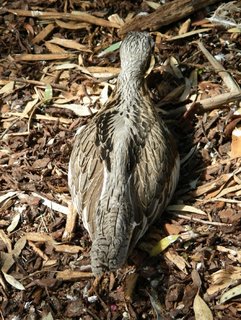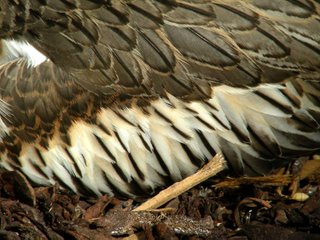From ferny streams, unearthly screams
Are heard in the midnight blue;
As afar they roam to the shepherd's home,
The shrieks of the wild Curlew!
The Song of the Curlew by Henry Kendall
 If you've spent any time in the north, you'll be familiar with this bird. You might not have seen one face to face but you'll certainly have heard its wailing call. Like the glorious carolling of the Australian magpie*, it is one of the definitive sounds of the bush.
If you've spent any time in the north, you'll be familiar with this bird. You might not have seen one face to face but you'll certainly have heard its wailing call. Like the glorious carolling of the Australian magpie*, it is one of the definitive sounds of the bush.The bush thick-knee or bush stone-curlew (Burhinus grallarius) used to be widespread but has decreased in some areas. Its decline is attributed to changes in land use but could also be due, in part, to birds being flattened by boots flung out of bedroom windows.
 Bush thick-knees are nocturnal. They gather together on open ground (e.g. a garden) and call. One starts. The others join in. The maniacal wails increase in intensity until they reach a crescendo. Then they all stop. After a period of silence, they begin again.
Bush thick-knees are nocturnal. They gather together on open ground (e.g. a garden) and call. One starts. The others join in. The maniacal wails increase in intensity until they reach a crescendo. Then they all stop. After a period of silence, they begin again.I thought that they stopped suddenly because they became ashamed of their mass hysteria. They start again when they get over the embarrassment. But a friend suggested an alternative theory—they stop when they've woken everyone up. They them wait until everyone's dropped off to sleep and ...
Or they could just be communicating with each other, regardless of the humans carrying on around them. You never know.
 When you encounter one during the day, it will usually freeze and rely on its camouflage for protection. The cryptic coloration works well if the bird is resting on the ground. But if it's out and about, it is much more obvious. Those beautiful big yellow eyes give it away.
When you encounter one during the day, it will usually freeze and rely on its camouflage for protection. The cryptic coloration works well if the bird is resting on the ground. But if it's out and about, it is much more obvious. Those beautiful big yellow eyes give it away.The best place to see them in the wild? Magnetic Island, near Townsville. But take ear plugs and move your boots to another room. It's a privilege to have the wildlife in such close proximity but your perspective tends to change at 3 a.m. ...
_____________
*Add your own favourite
[These photos are of a captive bird at Serendip Sanctuary]